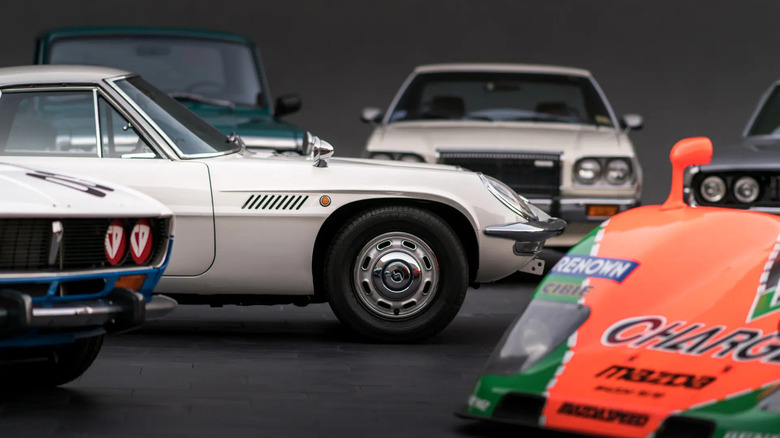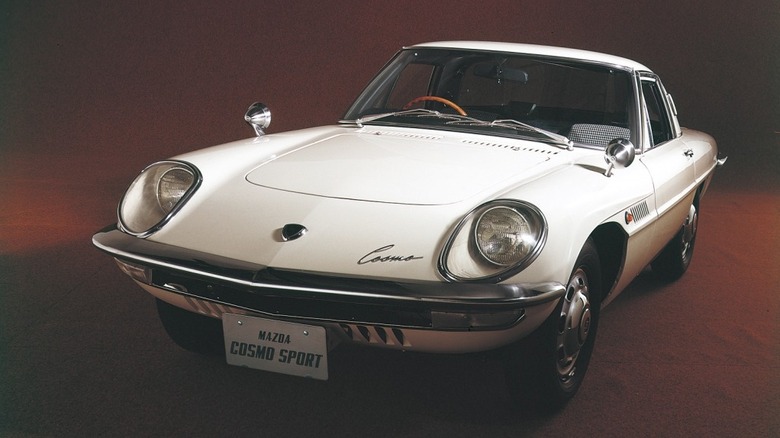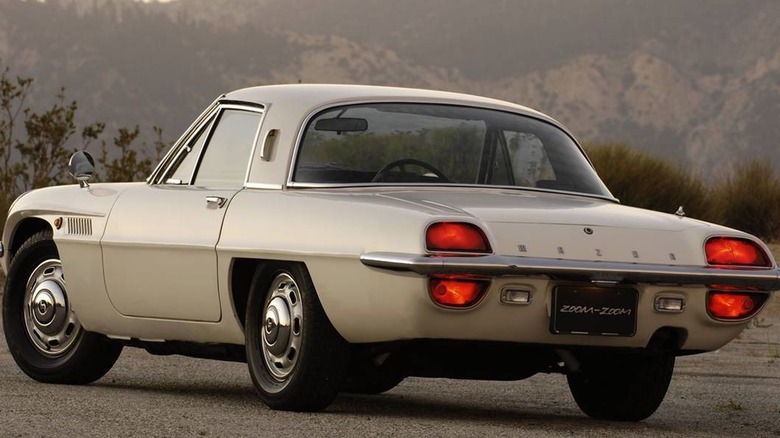Mazda Owes Its First Appearance In The US To This American Aircraft Company
Mazda's automotive history dates back to 1931 when the company formerly known as Tokyo Cork Kogyo Co. produced its first self-powered vehicle, an auto-rickshaw that was essentially a tricycle. Common to other Japanese industrial firms, Mazda produced military equipment during World War II before facing a long and arduous recovery period.
This struggle culminated in the 1960 Mazda R360 Coupe, the company's first postwar car and their first enclosed "car" as we know it, one of a wave of new-model kei cars. These were hypercompacts built to be cheap and available for everyone, using advanced mass-manufacturing techniques adopted from overseas companies, beginning Mazda's international pursuits. However, small kei cars like these were inadequate for America's interstate highway system, a point driven home with the commercial failure of the Subaru 360. It took another decade before Mazda committed to exporting to the United States, but when they did, it was with none other than the Toyo Kogyo Mazda Cosmo Sport 110S Series I, better known as the first-generation Mazda Cosmo.
But that was 1970; a little-known fact is that two Mazda 110Ss, Mazda's designation for export-bound Cosmos, actually found their way onto American shores in 1967 as part of a technology demonstration. And the importer was none other than the Curtiss-Wright Aircraft company, the same company that produced warbirds like the P-40 Warhawk. As an industrial and engine manufacturer, Curtiss-Wright expressed interest in perfecting Wankel engines, and purchased these cars to study Mazda's engine design architecture. Let's dive in and discuss the fascinating history of the 110S (hereafter the "Cosmo") and how it came to U.S. shores.
History of the first Wankel-powered Mazda
While it's not the first mass-produced Wankel-powered car ever — that title goes to the NSU Spider – the striking design of the Mazda Cosmo left an indelible impression in 1967. This was a hand-built car, with one completed per day on average, featuring a classic two-seater design language similar to a compact Ford Thunderbird married to a Chevrolet Corvair. In other words, it was a massive departure from the typical Japanese 360cc kei cars of the era.
Moreover, Wankel technology at the time was perceived as unreliable, a point which Mazda fought against beginning with the Cosmo. The car proved so well-made and dependable that it entered the infamous 84-hour Marathon de la Route, one of the longest races ever sanctioned, in 1968. It finished a remarkable fourth place overall after completing over 5,000 miles of racing in one shot.
Still known as Toyo Kogyo at this time, Mazda was keen to show off its exceptional sports car and its new engine to anyone paying attention, including the United States. To this end, the Curtiss-Wright Aircraft company saw potential in the unique powertrain, acquiring all sorts of rotary-engined machinery and equipment. This led to the first Cosmos finding their way stateside, a pair of 1967 110S export models, which Curtiss-Wright used as a design study. The reason being, while Wankel engines are oil burners and relatively inefficient, they're far more compact than traditional piston engines of identical power figures. A Cosmo's engine is less than 1.0L and produces 110 horsepower, for instance. Such figures proved lucrative for aircraft engines, though the advent of the Jet Age relegated Wankels to specialist applications; that said, some kit planes still use Mazda Wankels today.
What happened to the Cosmo test cars?
It took several years for the Wankel to really warm up to American audiences due to multiple factors. First and foremost, it was still a Japanese car, and the common sentiment of the time was that Japanese cars were seen as these cheap, ugly, and slow compacts; this was the heyday of the Muscle Era, after all. Second, other companies tried getting Wankels to run reliably, but only Mazda actually made it work, so the engine's reputation wasn't outstanding. Moreover, these were hand-built cars, and commanded high prices to match. They featured sleek, futuristic styling, an engine nobody outside of niche automotive circles had heard of yet, and it came from a country that was only a serious international player for less than two decades.
Consequently, it took Mazda three years after its first States-bound Cosmo before they opened up the export market, establishing Mazda Motor of America in Seattle in 1970. The company's first official exports left Japanese shores on April 14, 1970, with the R100, also known as the Mazda Familia. This car was actually originally exported to Canada in 1968 as an experimental gateway to the United States market.
As for the earlier Curtiss-Wright 1967 Cosmo test mules, these cars found their way into private hands. The first was purchased by Jay Leno and the second by collector Glenn Roberts of Phoenix, Arizona. In 2007, Mazda North America purchased the latter, which was in almost totally original condition, down to the original fuel cap. The company still regularly exhibits and drives the car to this day, maintaining it in perfect driving condition alongside other famous rotary-powered machines. So don't worry; unlike the ill-fated Furai concept, these Mazdas are thankfully alive and well.


